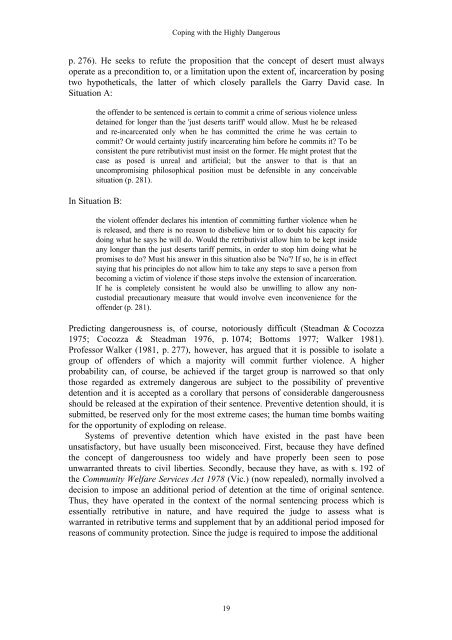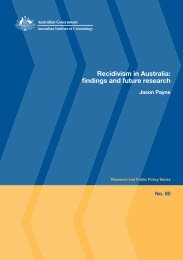Coping with the highly dangerous : issues of principle raised by ...
Coping with the highly dangerous : issues of principle raised by ...
Coping with the highly dangerous : issues of principle raised by ...
Create successful ePaper yourself
Turn your PDF publications into a flip-book with our unique Google optimized e-Paper software.
<strong>Coping</strong> <strong>with</strong> <strong>the</strong> Highly Dangerous<br />
p. 276). He seeks to refute <strong>the</strong> proposition that <strong>the</strong> concept <strong>of</strong> desert must always<br />
operate as a precondition to, or a limitation upon <strong>the</strong> extent <strong>of</strong>, incarceration <strong>by</strong> posing<br />
two hypo<strong>the</strong>ticals, <strong>the</strong> latter <strong>of</strong> which closely parallels <strong>the</strong> Garry David case. In<br />
Situation A:<br />
<strong>the</strong> <strong>of</strong>fender to be sentenced is certain to commit a crime <strong>of</strong> serious violence unless<br />
detained for longer than <strong>the</strong> 'just deserts tariff' would allow. Must he be released<br />
and re-incarcerated only when he has committed <strong>the</strong> crime he was certain to<br />
commit? Or would certainty justify incarcerating him before he commits it? To be<br />
consistent <strong>the</strong> pure retributivist must insist on <strong>the</strong> former. He might protest that <strong>the</strong><br />
case as posed is unreal and artificial; but <strong>the</strong> answer to that is that an<br />
uncompromising philosophical position must be defensible in any conceivable<br />
situation (p. 281).<br />
In Situation B:<br />
<strong>the</strong> violent <strong>of</strong>fender declares his intention <strong>of</strong> committing fur<strong>the</strong>r violence when he<br />
is released, and <strong>the</strong>re is no reason to disbelieve him or to doubt his capacity for<br />
doing what he says he will do. Would <strong>the</strong> retributivist allow him to be kept inside<br />
any longer than <strong>the</strong> just deserts tariff permits, in order to stop him doing what he<br />
promises to do? Must his answer in this situation also be 'No'? If so, he is in effect<br />
saying that his <strong>principle</strong>s do not allow him to take any steps to save a person from<br />
becoming a victim <strong>of</strong> violence if those steps involve <strong>the</strong> extension <strong>of</strong> incarceration.<br />
If he is completely consistent he would also be unwilling to allow any noncustodial<br />
precautionary measure that would involve even inconvenience for <strong>the</strong><br />
<strong>of</strong>fender (p. 281).<br />
Predicting <strong>dangerous</strong>ness is, <strong>of</strong> course, notoriously difficult (Steadman & Cocozza<br />
1975; Cocozza & Steadman 1976, p. 1074; Bottoms 1977; Walker 1981).<br />
Pr<strong>of</strong>essor Walker (1981, p. 277), however, has argued that it is possible to isolate a<br />
group <strong>of</strong> <strong>of</strong>fenders <strong>of</strong> which a majority will commit fur<strong>the</strong>r violence. A higher<br />
probability can, <strong>of</strong> course, be achieved if <strong>the</strong> target group is narrowed so that only<br />
those regarded as extremely <strong>dangerous</strong> are subject to <strong>the</strong> possibility <strong>of</strong> preventive<br />
detention and it is accepted as a corollary that persons <strong>of</strong> considerable <strong>dangerous</strong>ness<br />
should be released at <strong>the</strong> expiration <strong>of</strong> <strong>the</strong>ir sentence. Preventive detention should, it is<br />
submitted, be reserved only for <strong>the</strong> most extreme cases; <strong>the</strong> human time bombs waiting<br />
for <strong>the</strong> opportunity <strong>of</strong> exploding on release.<br />
Systems <strong>of</strong> preventive detention which have existed in <strong>the</strong> past have been<br />
unsatisfactory, but have usually been misconceived. First, because <strong>the</strong>y have defined<br />
<strong>the</strong> concept <strong>of</strong> <strong>dangerous</strong>ness too widely and have properly been seen to pose<br />
unwarranted threats to civil liberties. Secondly, because <strong>the</strong>y have, as <strong>with</strong> s. 192 <strong>of</strong><br />
<strong>the</strong> Community Welfare Services Act 1978 (Vic.) (now repealed), normally involved a<br />
decision to impose an additional period <strong>of</strong> detention at <strong>the</strong> time <strong>of</strong> original sentence.<br />
Thus, <strong>the</strong>y have operated in <strong>the</strong> context <strong>of</strong> <strong>the</strong> normal sentencing process which is<br />
essentially retributive in nature, and have required <strong>the</strong> judge to assess what is<br />
warranted in retributive terms and supplement that <strong>by</strong> an additional period imposed for<br />
reasons <strong>of</strong> community protection. Since <strong>the</strong> judge is required to impose <strong>the</strong> additional<br />
19















